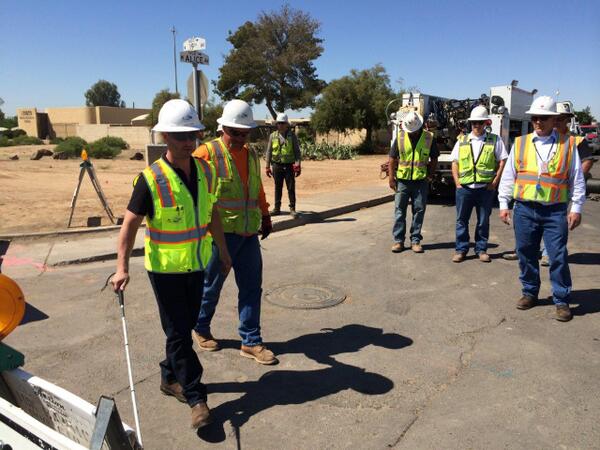
Walking through a construction zone where the pedestrian route is constantly changing is hard enough. Try doing it when you’re visually impaired. That’s what a group of Sundt and Stacy and Witbeck employees did on a recent afternoon to try to get a better understanding of what visually impaired pedestrians experience as they navigate their way through the light rail construction project the partnership is building in Phoenix. The Sundt/Stacy and Witbeck team is constructing a 3.2-mile addition to the existing Valley Metro Light Rail system, known as the Northwest Extension.
“There are several visually impaired people who live along the construction route, and one in particular who is very active,” says Chris Elison, Sundt field engineer. “He walks along a one-mile portion of the route several times a day for work and to meet with friends. It came to our attention that he had a couple of difficult experiences figuring out where to walk when the pedestrian walkway was re-rerouted. Sometimes it’s re-routed several times in one week. The sidewalk that’s open one day could be closed the next, and until recently we relied mainly on signage to indicate the change.”
Several members of the project team took a class that gave them an overview of the newest guidelines pertaining to “canable” rails (guides for people using canes), and then they hit the streets using canes and wearing black-out glasses. While one person tried to navigate the temporary walkway without relying on visual cues, the others studied that person’s movements to get a better understanding of the difficulties.
“It was really hard to figure out where to go; we learned a lot from the experience,” Chris explained. “The canable rail provides very important cues. Wherever it’s pointing is where the person relying on it is going to try to go. If you just have a “sidewalk closed” sign with an arrow pointing right or left, you’ve basically created nothing but a tripping hazard for the visually impaired. You have to have the rail positioned at just the right angle for them. There’s more to think through than most people realize. The investment in training was well worth it. We have a much safer project now, thanks to the new guidelines and our real-world training exercise.”
The Northwest Extension is expected to serve approximately 5,000 riders per day when it is complete. The transportation construction project is Sundt’s fourth for Valley Metro Light Rail. In 2008, Sundt/ Stacy and Witbeck completed more than half of the original 20-mile “starter” section of the transit system (Line Section 4 and Line Section 5), plus the system’s maintenance and operations facility.